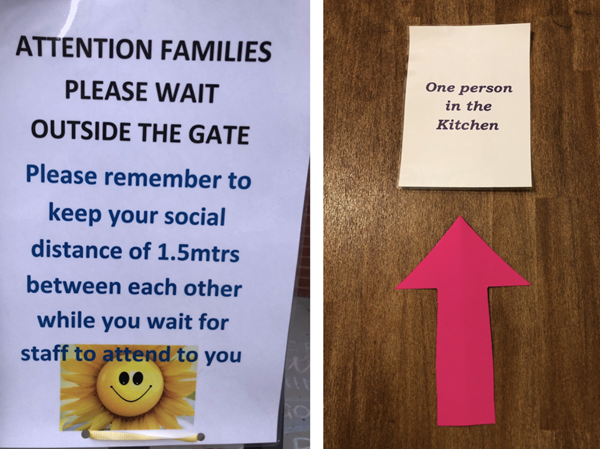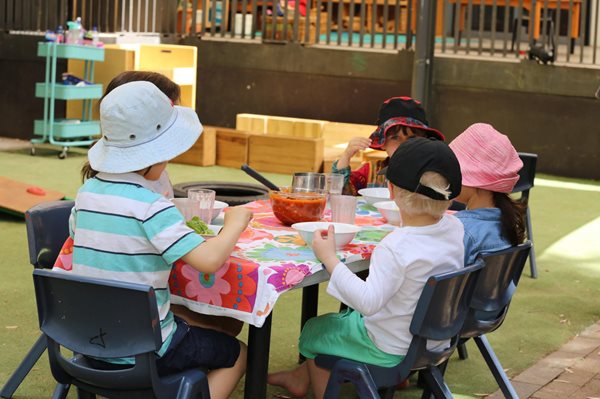The government has provided information about COVID-19 for NSW schools, universities and childcare centres including how to encourage good hygiene, social distancing, preparing for illness and communicating changes. But what does that look like in reality in an ECEC setting?
In this two-part series, we speak with services in southern Sydney and Lismore to find out what they are doing to keep staff and children safe by changing how families and staff interact, how the service is cleaned, and how staff are rostered – including accessing the JobKeeper allowance.
Gymea Community Preschool
Gymea Community Preschool is located in Sydney’s Sutherland Shire. The service usually caters for 120 3-5 year olds over a week (60 per day). They are currently averaging 15-20 per day. We spoke with Early Childhood Teacher Jennifer Moglia about the many changes the centre has made to keep staff and families as safe as possible.
Distancing
Distancing practices at Gymea Community Preschool have evolved rapidly over the past month, as new insights and government messaging came to light. The team are constantly reflecting on what they are doing, whether they can do more, and how they can achieve what is required while still keeping relationships with families and the childrens’ best interests in mind.
“Our messaging has also evolved,” says Jennifer. “At first we focused on connecting with families not attending in order to support them as they adjusted to financial hardship. Now, in addition to this, we also pay attention to thanking them for supporting all the physical distancing requirements we have as well as informing them of ways we will support remote learning.”
Radical changes to drop off and pick up
 Crosses are now marked outside the gate to signal safe distancing for families on arrival
Crosses are now marked outside the gate to signal safe distancing for families on arrival
The centre’s Nominated Supervisor works with an educator to greet families and children at the gate. Either the educator or the parent takes the child’s temperature (an Ipad and books are available for the child to look at while this is happening). The thermometer is cleaned and rotated between children. The educator signs the child in and takes the child into the room to wash their hands. Other families are asked to wait until the educator returns.
In the afternoon, the educators take the children to the front gate when the parents arrive and sign them out on behalf of the parent.
“At first these practices felt uncomfortable,” admits Jennifer. “However, our educators do a wonderful job in making sure they are always positive, calm and reassuring, as both the families and children adjust. We have even had families who work in the health sector compliment us and let us know that these practices should be considered post-COVID.”
Phone calls have increased
Educators are calling families more often in order to keep building connections while reducing the time spent at the front gate communicating messages.
Signage has increased
There are many new signs throughout the centre, including information about how many adults can gather in different areas (only one person at the photocopier and two in the staff room, with additional chairs having been removed).
Signs for families have been added at the front of the service to encourage hygiene practices, while a masking tape line indicates the distance adults should stand in relation to the foyer desk.
“We make an effort to make displays out the front each day in addition to our digital communication methods to ensure that families who are no longer coming into the preschool know about all the fun that we’ve had during the day. This includes books that have been read that day, artworks and information about other activities.”

Staff lunch break arrangements have changed
Staff breaks are now arranged in terms of how many staff can be in an area at one time. Staff are encouraged to not leave the building during breaks to avoid any contamination being brought back into the preschool building.
Children’s mealtimes have changed
Children are engaging in staggered, small group mealtimes in order to keep group sizes to a minimum.
 How can you encourage children to space out when sitting together? Consider having less chairs at the table and placing those chairs as far apart as possible.
How can you encourage children to space out when sitting together? Consider having less chairs at the table and placing those chairs as far apart as possible.
Cleaning and hygiene
All cleaning practices have been increased, and staff have been made aware that cleaning is never ‘done’ – it’s always a focus.
The vigilant focus on cleaning now includes:
- Cleaning by the centre’s cleaner has increased from once to twice a day, including more regular equipment and toy cleaning (JobKeeper allowances have helped to facilitate this).
- Every time an adult uses a pen, there is a used jar nearby for it to be placed. It is cleaned and placed back in the clean jar each morning and afternoon.
- High touch surfaces such as door handles, screens and keyboards are cleaned by an educator every two hours.
- Signage informs staff of increased cleaning requirements, for example, the front desk is to be wiped over after each user.
- Staff are assigned cleaning tasks so that it is not left to chance – it becomes a part of their daily responsibilities. Supervision is planned to allow for these tasks to be attended to while ratios are maintained.
Changes to staffing
As the number of children dropped, the team needed to look at the best way to engage staff and repurpose spaces. Jennifer says that a lot of work has gone into the current roster.
“Adding in all the additional measures including cleaning, Zoom group times for remote learning, screening, greeting and communication has really helped us to know how many staff we need on-site and where they are needed,” says Jennifer. “Logistically it was a big process, but a very important one. We needed to stay connected to our service goals, including providing a high-quality education and care program in a safe and healthy environment.”
One of the first measures the service put in place was to review staffing arrangements to see who needed to be onsite and who could work from home. This required the preparation of a work from home document which was used to guide 1:1 meetings with staff.
“In the beginning, a casual arrangement was made and some staff began to work from home. This has since turned into an organised roster that rotates all staff between direct care and education of children, and work from home or other tasks,” shares Jennifer.
“The other tasks came about as we realised that some staff could not work from home for various reasons but there were other things that they could be doing. This led us to close off one of the classrooms to support these staff to complete other tasks while remaining physically distant. The organised roster reflects staff skills and qualifications, and ensures that there is always a familiar face for children coming into the service.”
The JobKeeper program has played a big part in enabling each team member to stay engaged in some capacity, particularly now that the outreach program is being rolled out. JobKeeper has also provided the ability to increase the hours for the centre’s cleaner and to engage one of the regular casuals to supplement educators working on the Outreach Program.
Children attending
Originally the team felt very confident that all children could attend, but as more advice and research came out, they became aware of the need to adapt practices to increase the safety for children, staff and families.
This has led to an awareness of the need for higher ratios in order to maintain quality care for the children attending, including sufficient supervision and physical distancing as well as the extra hygiene and cleaning practices. JobKeeper has helped to facilitate this. The number of children physically accessing the service has had to be capped, with an outreach program in place for children who have alternative care.
Great importance is put on ensuring that children at home are well supported and that as many as possible, particularly those in vulnerable or challenging circumstances, can physically attend.
“Having close relationships with our families and knowing them as well as we do, we actually have a high number who need us now more than ever,” says Jennifer. “Some may not have been considered vulnerable before, but they are now. Families of children with high needs have had their therapy suspended and we are their only respite. Families who have lost work are suffering from financial hardship. We are hearing from parents that they are seeing their children regress in some behaviours. All of this is very concerning and we know we have a role to play to support our community.
“It is a time we need to self-reflect and action strategies around quality area 6: Collaborative partnership with families and communities. These actions will have a significant impact on children’s inclusion and wellbeing. It is also a time to reflect on the rights of the child and how we can change to enable and protect these rights.”

Next week we share how a service in Lismore on the NSW far north coast is keeping employees and families safe.
Member resources
Members, please log in to view. Any issues accessing member resources, please call 1800 157 818
Important links
Become a CELA member
